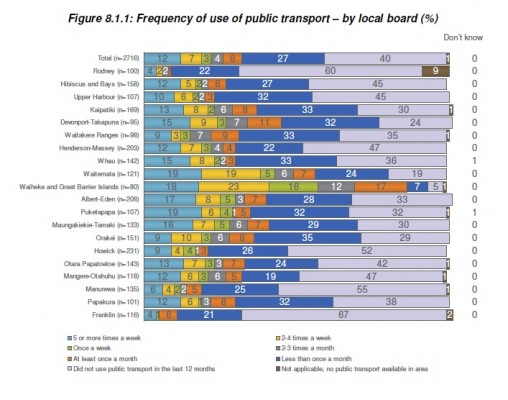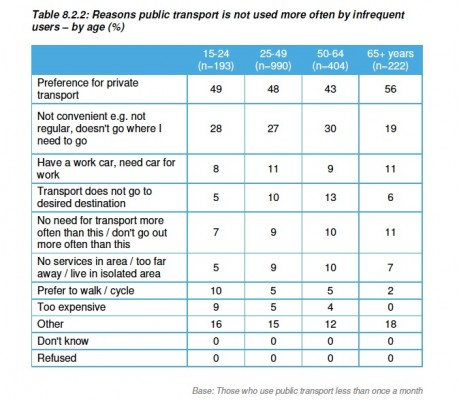1 In 5 Aucklanders Use PT?
One in 5 Aucklanders use public transport, according to the results of a biennial Quality of Life survey, Conducted by research company Nielsen, conducted by research company Nielsen.
12% use it 5 or more times a week and 7% use it 2 to 4 times a week.
Areas with heavy use is Waiheke and Great barrier islands (415 of those asked in those areas) -which is understandable as many use buses to get around Waiheke or get to the ferry.
Next was those living in the Waitemata district (38%).
The survey found that in Auckland the number of people using public transport (PT) has increased from 47 to 59 per cent in six years. 72 per cent of people thought PT was safe, 57 per cent thought it was easy to get to, 47 per cent thought it was reliable, 46 per cent thought it was frequent and 42 per cent thought it was affordable.
- Those less likely to use Pt twice a week are those living in Franklin (only 4%), Rodney (6%), Manurewa (11%) and Howick (12%).
- Those most likely to use PT regularly are aged 15 to 24 years (47% compared to the 19% Auckland average), which suggests money and no car ownership are factors.
- Those less likely to use PT regularly are those aged 50 to 64 (9%), 25 to 49 (12%) and 65 and over (14%).
- Those more likely to use PT regularly are of Pacific ethnicity (26% ) and Asian/ Indian (25%)
- Those less likely are of European ethnicity (16%)
- It confirms the stereotype about PT - that those on $20,000 a year or under are more likely to use pT and those over $70,000 not
- There is no significant gender differences on preferences
- Of those who don’t use PT, half say they prefer their own transport - a quarter say it’s not convenient - not regular or doesn’t go where I want to go
Read the survey here - PT starts about pg 269













5 Comments
Lets hope that national don’t use this to say that we should still have more motorways.
National will use ANYTHING to argue against public transport.
They will use stories of failure as proof why we shouldn’t fund it better.
They will use stories of success as proof that we don’t need more funding.
You mentioned it is biennial survey. Has it been done before or is this a new initiative under the super city?
It would be interesting to compare to previous data if it was available.
@Oscar Hi. The biennial Quality of Life survey measures the perceptions of over 6,000 residents living in eight of the country’s largest cities, from Auckland to Dunedin. Conducted by research company Nielsen, the survey is jointly funded by the relevant councils, and is part of the wider Quality of Life in New Zealand’s Largest Cities project.
he Quality of Life 2010 survey is the fourth nationwide survey in a partnership between eight councils: Auckland, Hamilton, Tauranga, Wellington, Porirua, Hutt, Christchurch and Dunedin.
The survey is part of an ongoing series of surveys and research exploring quality of life and well-being issues. Topics covered include:
* Quality of life
* Health and well-being
* Crime and safety
* Community, culture and social networks
* Council processes
* Built environment
* Public transport
* Lifestyle - work and study
Information obtained from the survey will be used to help inform central and local government policy makers.
Survey interviews were conducted over the telephone with a total New Zealand sample of 6,279 people, with a margin of error of +/- 1.2%.
http://www.qualityoflifeproject.govt.nz/
Yep, they surveyed me on the phone, after an initial letter telling me about having been selected.
Happily I was able to give them a pretty upbeat opinion without having to lie trough my teeth. And of course I supported the call for more PT